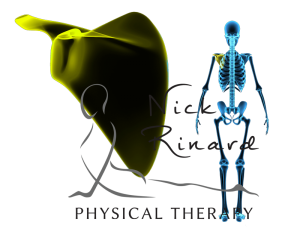The case study I would like to share with you today is only the second hip derangement of this type that I have seen. “Jim” was a 55 year old male who presented with right hip pain that started for no apparent reason 5-6 months prior to coming to physical therapy. He said the pain was provoked only when he was walking, but it occurred consistently at a distance of about 50 to 100 yards. Often it was so painful he could not continue walking. Jim figured out that changing his right foot position enabled him to walk a little further, albeit slowly, and then he could resume normal walking for another 50 yards or so. He would change the foot position by stepping partway onto a curb or raised ground such that the outer edge of his foot was tilted up (eversion, as we therapists call it), and then he would angle his right knee inwardly. That was the only way he had found to improve walking, but the hip just would not stay better.
In desperation, Jim said he had looked online and tried numerous “hip exercises” without any relief. He consulted his doctor, who recommended MDT, which we do here at Nick Rinard Physical Therapy.
Assessment
The mechanical assessment was positive for only two findings: limited and painful hip motion into flexion (folding the knee to chest), and weak and painful testing of hamstring resistance. The protocol for ruling out a joint derangement is to repeat motions to determine if the baselines change. The question is which motion to repeat. One can move either into the most painful direction, go the opposite direction, or check rotations. I chose to go into the most painful direction, in this case, flexion. But before testing I wanted to establish how far Jim could walk in the clinic before his pain started. By the time he walked one length of the hallway and back, he reported pain. I then instructed Jim to bend his knee to chest (compressing the groin) repeatedly and after 20 to 30 times. It produced his familiar pain initially, then the pain abolished and his motion increased. I tested walking after that and Jim said there was no pain even after walking 3 lengths up and back through the hallway! I gave Jim his exercises and scheduled him for 2 days later.
Progress
When Jim returned he reported that he could walk longer distances without the pain starting, however, he still got to the point where he had to modify his foot position in order to continue. I knew we were on the right track, and the next step in treating a joint derangement is to progress forces. I did this manually by applying over-pressure, and instructed Jim to do it in standing by folding his chest down to his knee with it supported on a bench or chair. By the next visit, Jim reported that this had worked very well and he had not experienced any pain at all! So, the derangement was reduced and I needed to wean him off the home exercises to see if it would return or not. I gave him the weaning program and asked to see him back in 2 weeks.
Pain Free
After 2 weeks, Jim came back reporting that he had been able to walk unlimited distances! He resumed walking his dog, going on walks for exercise, and walking wherever, and whenever he wanted. He reported his longest walk lasted 4.5 hours. He said there was no return of the original hip pain from which he had suffered for months. However, on his last two walks, he had started noticing a new hip pain, this time in the front, not on the sides. I re-checked his baselines and neither flexion motion nor resisted hamstrings were painful. That meant it could not be a re-derangement. Resisted hip flexion was painful, and that was new. I concluded that his sudden ability to walk pain-free resulted in his over-doing it. Jim had increased walking too fast and gotten a minor tendonitis. That was easy to treat, and by his next visit, Jim was pain-free again and able to progress walking, though this time more gradually, which was safer.
Successful Treatment
Jim’s hip treatment was obviously a success. It took only 4 visits. This hip derangement was unique because the direction that reduced it (flexion); I have only seen one other hip derangement require flexion to reduce it. The fact that Jim resumed normal activity too fast is typical of reduced derangements – the patient feels so good that they over do it. Luckily in Jim’s case, we found the new problem and fixed it just as fast as we found and fixed his chronic hip pain.
More
Last week, I had a patient come into the clinic with neck pain that had started the week before. He had been a patient in the past and knew that the sooner he got in for treatment, the better.
Terry had pain medial to his left shoulder blade. This pain was limiting him with sleeping and with driving, as left rotation caused pain. He was rating his pain a 4/10 at the time of the evaluation.
Evaluation and Assessment

Scapula connects Upper Arm with Collar Bone
During the evaluation, left and right rotation motions produced pain medial to the left scapula. Upon palpation, the musculature where the pain was produced was very tender, acting like trigger points. I chose not to treat the trigger points, as these things are likely secondary to the real problem: a derangement.
During the repeated movement assessment, I had Terry go through retraction, extension and flexion. When we tested repeated left rotation, Terry’s pain decreased with repetition. Terry was sent home performing repeated left rotation with over-pressure. By his next visit, his pain was significantly decreased and the trigger points of the muscles had also decreased with pain when palpated. I had Terry increase the frequency of which he was to perform the rotation exercise. By the next visit, Terry had abolition of all pain, no limitation with sleeping or driving and the trigger points were completely gone!
Getting to the Root of the Problem
The Mechanical Diagnosis and Therapy (MDT) Method is very effective at getting to the root of the problem. When the core issue is fixed, the secondary impairments almost always resolve on their own. If a clinician is always treating the symptoms and not the cause, this will lead to more visits, more time until recovery and more money from the patient. This is one of the fundamental reasons that we practice the MDT Method here at Nick Rinard Physical Therapy – to fix your core issues!
More
This week I will tell you about the rapid recovery of an ipsilateral shift. An ipsilateral shift was described by Robin McKenzie of the McKenzie Method®, and the treatment of this patient of the week follows Mechanical Diagnosis and Therapy® principles exactly as I was taught them. The patient presents with a lateral shift deformity of the trunk shifted away from the side of dominant pain.
Gerry, (not his real name), arrived with his wife to clinic after suffering 10/10 pain in his back, buttock, and thigh, and had a severe ipsilateral shift. This had been present for 2 weeks, and Gerry stated it had recently worsened after a massage session. Gerry could not recall any incident that caused injury or otherwise caused the onset of pain. He stated he had tried standard chiropractic treatment with no effect.
While I was taking Gerry’s history, his wife reported that he had to crawl to get around their home for the first hour after getting out of bed. Even at his best, he could barely make it down the hall to my office. He was completely unable to dress himself, drive or go to work.
The shift made the mechanical diagnosis easy. It was most likely a mechanical derangement. Any attempt Garry made to bend forward or backward resulted in severe pain, and nearly no range of motion. Trying to correct the shift himself, even when leaning against the wall for support, also resulted in severe pain and no gain in range of motion.
Therefore, manual forces had to be applied by the MDT therapist – in this case – me! (I have achieved certification in Mechanical Diagnosis and Therapy® by the McKenzie® Institute, designated by “Cert. MDT”).
Manual shift correction is described in various published works by Robin Anthony McKenzie, the originator of the McKenzie® Method of Mechanical Diagnosis and Therapy®. It involves full body pressure against the hips and opposite side of the trunk provided by the therapist. It can be painful to experience, however, only pain that centralizes is permitted, according to McKenzie®. As I learned in my McKenzie® training from expert therapist Colin Davies, the duration of force application can last a long time – up to 45 minutes. Gerry’s shift was challenging. I applied force for 45 minutes, but still there was only minimal correction of his shift!
By day two, Gerry could walk better, but was still shifted. This time, manual force corrected the shift in 15 minutes. The next day Gerry could correct his own shift and he was not taking any pain medication anymore!
Now, one week later, he is no longer shifted at all. He can dress himself, including his socks and shoes, drive, and go to work. Regarding walking, he only needed to swing his Right arm normally again – he had been supporting his back with it and lost normal gait in the interim. He reported pain levels of 1-2/10.
Treating Gerry was very satisfying. His mechanical diagnosis was clear, treatment was difficult, but not confusing. I credit the McKenzie® Method of Mechanical Diagnosis and Therapy® with giving me the expertise to be so successful in treating this, and other painful spine and joint conditions. Thank you for your interest in the clinical case study of the week!
Nick Rinard MPT, Cert MDT
More

